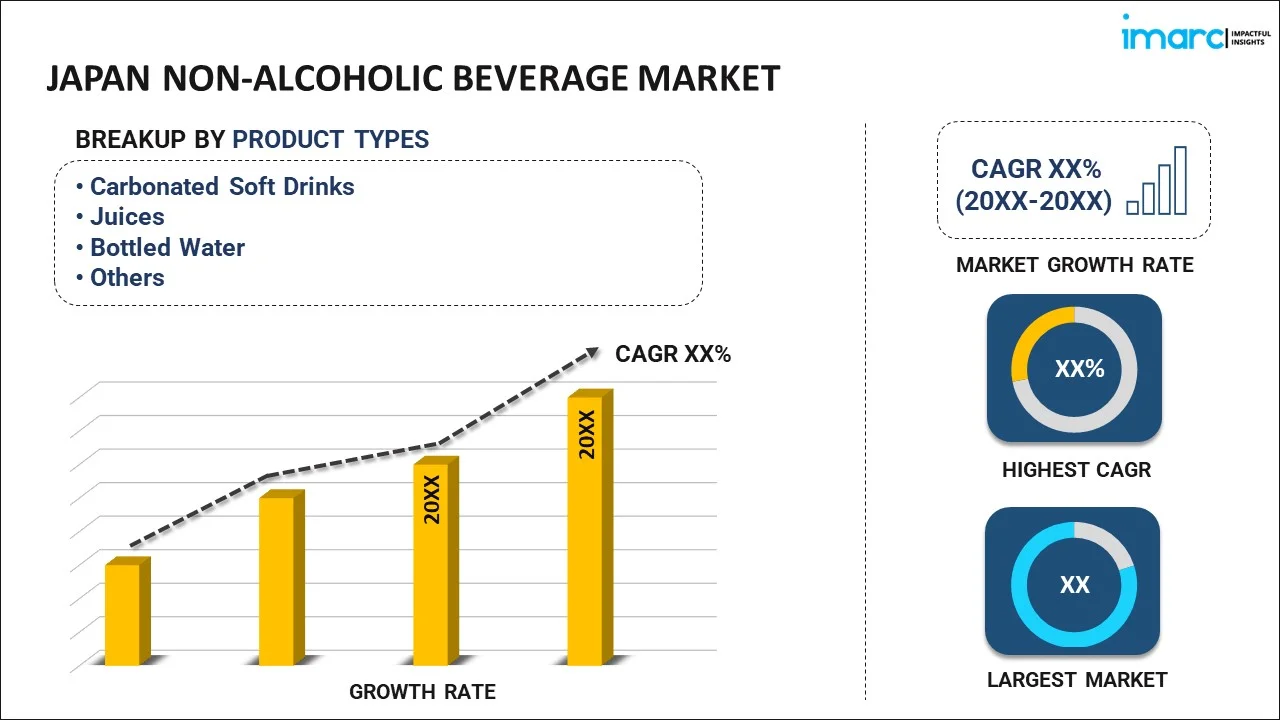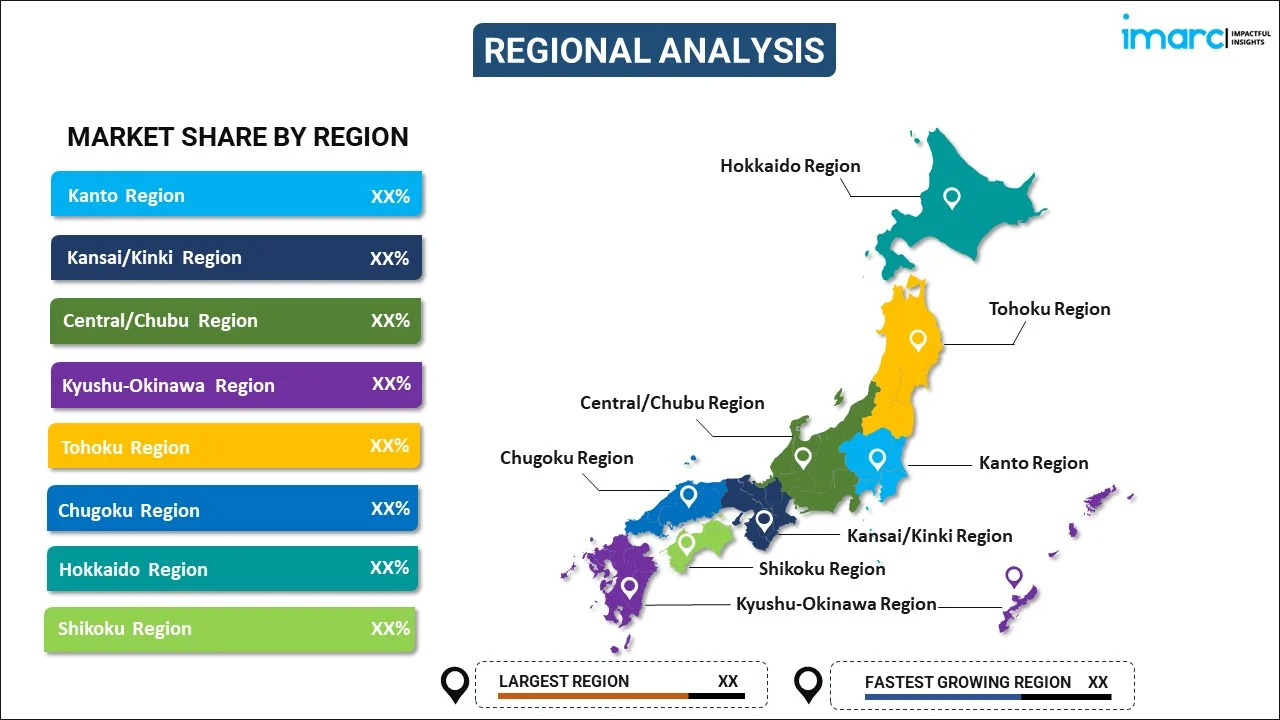
Japan Non-Alcoholic Beverage Market Report by Product Type (Carbonated Soft Drinks, Juices, Bottled Water, Sports and Energy Drinks, RTD Tea and Coffee, and Others), Packaging Type (Bottles, Cans, Cartons, and Others), Distribution Channel (Retail, Food Service, Supermarkets and Hypermarkets, Online Stores, and Others), and Region 2025-2033
Market Overview:
Japan non-alcoholic beverage market size reached USD 37.6 Billion in 2024. Looking forward, IMARC Group expects the market to reach USD 75.8 Billion by 2033, exhibiting a growth rate (CAGR) of 7.70% during 2025-2033. The increasing demand for healthier beverage options that are low in sugar, free from artificial additives, and offer functional benefits like hydration, vitamins, or antioxidants, is primarily driving the market.
|
Report Attribute
|
Key Statistics
|
|---|---|
|
Base Year
|
2024 |
|
Forecast Years
|
2025-2033 |
|
Historical Years
|
2019-2024
|
| Market Size in 2024 | USD 37.6 Billion |
| Market Forecast in 2033 | USD 75.8 Billion |
| Market Growth Rate (2025-2033) | 7.70% |
Non-alcoholic beverages, also known as soft drinks, encompass a wide variety of drinkable refreshments that do not contain alcohol. These beverages serve not only as thirst quenchers but also as integral components of many cultures, rituals, and daily routines. Ranging from traditional drinks like tea, coffee, and cocoa to the effervescent world of sodas and from refreshing fruit juices to health-centric options like kombucha and herbal infusions, these drinks cater to a diverse array of tastes and preferences. Often, the consumption of such beverages is influenced by factors like climate, regional ingredients, and cultural practices. Innovations in the beverage industry have also led to the introduction of new flavors and combinations, further expanding the spectrum of choices. As more individuals gravitate towards health-conscious choices, the demand for organic, low-calorie, and nutrient-rich non-alcoholic beverages has risen, indicating a dynamic shift in consumption patterns.
Japan Non-Alcoholic Beverage Market Trends:
The non-alcoholic beverage market in Japan is experiencing robust growth, driven by several key factors. Firstly, changing consumer preferences has played a pivotal role in the market's expansion. Health-conscious consumers are increasingly opting for non-alcoholic alternatives over sugary, high-calorie drinks. Furthermore, the rising awareness of the harmful effects of excessive alcohol consumption has prompted many individuals to seek healthier beverage options. Additionally, the growing trend of mindful drinking has propelled the demand for non-alcoholic beverages. Consumers are seeking flavorful, sophisticated alternatives that allow them to enjoy social occasions without the intoxicating effects of alcohol. Consequently, innovative beverage companies have responded with a plethora of non-alcoholic options that cater to various tastes and preferences. Apart from this, the influence of marketing and branding, which has successfully created aspirational and trendy images of non-alcoholic beverage brands, appealing to younger demographics who are more health-conscious and socially aware, is expected to drive the non-alcoholic beverage market in Japan during the forecast period.
Japan Non-Alcoholic Beverage Market Segmentation:
IMARC Group provides an analysis of the key trends in each segment of the market, along with forecasts at the country level for 2025-2033. Our report has categorized the market based on product type, packaging type, and distribution channel.
Product Type Insights:

- Carbonated Soft Drinks
- Juices
- Bottled Water
- Sports and Energy Drinks
- RTD Tea and Coffee
- Others
The report has provided a detailed breakup and analysis of the market based on the product type. This includes carbonated soft drinks, juices, bottled water, sports and energy drinks, RTD tea and coffee, and others.
Packaging Type Insights:
- Bottles
- Cans
- Cartons
- Others
A detailed breakup and analysis of the market based on the packaging type have also been provided in the report. This includes bottles, cans, cartons, and others.
Distribution Channel Insights:
- Retail
- Food Service
- Supermarkets and Hypermarkets
- Online Stores
- Others
The report has provided a detailed breakup and analysis of the market based on the distribution channel. This includes retail, food service, supermarkets and hypermarkets, online stores, and others.
Regional Insights:

- Kanto Region
- Kansai/Kinki Region
- Central/ Chubu Region
- Kyushu-Okinawa Region
- Tohoku Region
- Chugoku Region
- Hokkaido Region
- Shikoku Region
The report has also provided a comprehensive analysis of all the major regional markets, which include Kanto Region, Kansai/Kinki Region, Central/ Chubu Region, Kyushu-Okinawa Region, Tohoku Region, Chugoku Region, Hokkaido Region, and Shikoku Region.
Competitive Landscape:
The market research report has also provided a comprehensive analysis of the competitive landscape. Competitive analysis such as market structure, key player positioning, top winning strategies, competitive dashboard, and company evaluation quadrant has been covered in the report. Also, detailed profiles of all major companies have been provided.
Japan Non-Alcoholic Beverage Market Report Coverage:
| Report Features | Details |
|---|---|
| Base Year of the Analysis | 2024 |
| Historical Period | 2019-2024 |
| Forecast Period | 2025-2033 |
| Units | Billion USD |
| Scope of the Report | Exploration of Historical and Forecast Trends, Industry Catalysts and Challenges, Segment-Wise Historical and Predictive Market Assessment:
|
| Product Types Covered | Carbonated Soft Drinks, Juices, Bottled Water, Sports and Energy Drinks, RTD Tea and Coffee, Others |
| Packaging Types Covered | Bottles, Cans, Cartons, Others |
| Distribution Channels Covered | Retail, Food Service, Supermarkets and Hypermarkets, Online Stores, Others |
| Regions Covered | Kanto Region, Kansai/Kinki Region, Central/ Chubu Region, Kyushu-Okinawa Region, Tohoku Region, Chugoku Region, Hokkaido Region, Shikoku Region |
| Customization Scope | 10% Free Customization |
| Post-Sale Analyst Support | 10-12 Weeks |
| Delivery Format | PDF and Excel through Email (We can also provide the editable version of the report in PPT/Word format on special request) |
Key Questions Answered in This Report:
- How has the Japan non-alcoholic beverage market performed so far and how will it perform in the coming years?
- What has been the impact of COVID-19 on the Japan non-alcoholic beverage market?
- What is the breakup of the Japan non-alcoholic beverage market on the basis of product type?
- What is the breakup of the Japan non-alcoholic beverage market on the basis of packaging type?
- What is the breakup of the Japan non-alcoholic beverage market on the basis of distribution channel?
- What are the various stages in the value chain of the Japan non-alcoholic beverage market?
- What are the key driving factors and challenges in the Japan non-alcoholic beverage?
- What is the structure of the Japan non-alcoholic beverage market and who are the key players?
- What is the degree of competition in the Japan non-alcoholic beverage market?
Key Benefits for Stakeholders:
- IMARC’s industry report offers a comprehensive quantitative analysis of various market segments, historical and current market trends, market forecasts, and dynamics of the Japan non-alcoholic beverage market from 2019-2033.
- The research report provides the latest information on the market drivers, challenges, and opportunities in the Japan non-alcoholic beverage market.
- Porter's five forces analysis assist stakeholders in assessing the impact of new entrants, competitive rivalry, supplier power, buyer power, and the threat of substitution. It helps stakeholders to analyze the level of competition within the Japan non-alcoholic beverage industry and its attractiveness.
- Competitive landscape allows stakeholders to understand their competitive environment and provides an insight into the current positions of key players in the market.
Need more help?
- Speak to our experienced analysts for insights on the current market scenarios.
- Include additional segments and countries to customize the report as per your requirement.
- Gain an unparalleled competitive advantage in your domain by understanding how to utilize the report and positively impacting your operations and revenue.
- For further assistance, please connect with our analysts.
 Inquire Before Buying
Inquire Before Buying
 Speak to an Analyst
Speak to an Analyst
 Request Brochure
Request Brochure
 Request Customization
Request Customization




.webp)




.webp)












